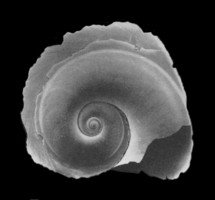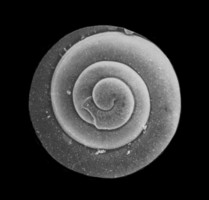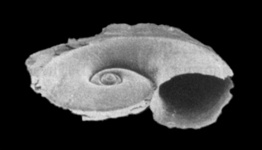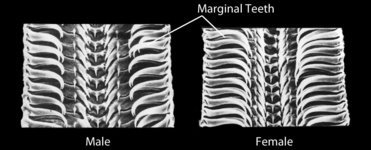Atlanta fragilis
Roger R. SeapyIntroduction
Atlanta fragilis is a large species (to 9 mm shell diameter). The shell is transparent and its surface smooth. The shell walls are thin and, as a consequence, the shell is fragile; hence the origin of the specific epithet, fragilis. The keel is tall, with a truncate leading edge, and penetrates between the last two whorls in shells larger than about 4 mm. The keel base is clear, lacking pigmentation. The spire consists of about 3-1/2 whorls and has a moderately-elevated conical shape. Eyes type b, operculum type b, and radula type II. The radula has a limited number of tooth rows (to about 70), and exhibits sexual dimorphism; the marginal teeth are shorter and more sharply bent terminally in males. The species was described from tropical central Atlantic waters, where it is rare in comparison with A. peronii and with which it is closest in shared characteristics. It has not been identified elsewhere; hence it is tentatively regarded as limited to the Atlantic Ocean.
Diagnosis
- Large species (to 9 mm shell diameter)
- Shell transparent (including the keel base), with a smooth surface
- Shell walls thin and fragile
- Keel tall, inserting between last two whorls in shells larger than about 4 mm
- Keel base clear, lacking pigmentation
- Spire consists of about 3-1/2 whorls
- Spire shape moderately elevated, conical
- Eyes type b
- Operculum type b
- Radula type II
- Marginal teeth sexually dimorphic; shorter and more sharply bent terminally in male radulae
Characteristics
- Shell
- Shell large, attaining a maximal diameter of 9 mm
- Shell transparent and completely colorless
- Surface of shell smooth, lacking sculpture
- Walls of shell thin and fragile; hence the specific epithet, fragilis. Wall thickness about 10 µm in the fifth shell whorl
- Keel tall with a truncate leading edge (see title illustration) and an unpigmented base
- Keel base clear, lacking pigmentation
- Keel penetrates between penultimate and final whorls in shells larger than about 4 mm (see title photograph); at about whorl 4-3/4 (Richter, 1993)
 Click on an image to view larger version & data in a new window
Click on an image to view larger version & data in a new window

Figure. Scanning electron micrographs of a Atlanta fragilis shell, viewed from the right side (left), and magnified view of spire (right). From Richter (1993, figs. 2 and 6, left). © 1993 G. Richter

Figure. Scanning electron micrograph of Atlanta fragilis shell photographed from the right side (see above) in tilted view. From Richter and Seapy (1999, fig. 7A). © 1999 G. Richter
- Spire of about 3-1/2 whorls; moderately elevated conical shape, with early whorls distinct due to incised sutures (see spire of larval shell in apertural view)
- Eyes type b; with very large lenses in adult animals
- Operculum type b (micro-oligogyre)
- Radula type II
- Radula large, with number of tooth rows limited to about 70
- Sexual dimorphism: marginal teeth shorter and more sharply bent terminally in males than in females
Comments
Atlanta fragilis was described by Richter (1993) from material collected from the tropical central Atlantic Ocean. The species shares the same eye, opercular, and radular types with other members of the A. peronii species group. Among these species, it is most similar to A. peronii in overall shell morphology, maximal shell size, and sexual dimorphism in the marginal teeth. The shell of A. fragilis is distinguished from other species by its thin, fragile walls (hence, the specific epithet, fragilis). Richter (1993) noted that the thickness of the wall in the fifth whorl is about 10 µm, compared with 22-25 µm in the fifth whorl in A. peronii. Other differences with A. peronii (cited in Richter, 1993 and in Richter and Seapy, 1999) include: (1) the keel, which is higher and penetrates deeper between the last two shell whorls in A. fragilis, (2) the keel base is clear, lacking pigmentation; in A. peronii the keel base of young individuals is clear, but becomes light brown to dark yellowish-brown with age, (3) the size of the eye lenses in adult animals is more than twice as large in A. fragilis; (4) the radula is longer and wider in A. fragilis, (5) the maximal number of tooth rows is higher in A. fragilis (70 compared with 60 in A. peronii), and (6) the spire of the larval shell is somewhat flatter in A. fragilis (see apertural views of larval shells of A. fragilis [above] and A. peronii [below]); although this difference is not seen in the spire of the adult shell. Lastly, Richter (1993) reported vertical distribution data for A. fragilis from opening-closing MOCNESS net tows taken during METEOR Expedition 51 in the tropical central Atlantic. Of the 135 adult specimens collected, about half were from 0-100 m tows and the other half were from 100-250 m tows. No information was included about the times of the tows, and so the possibility of nocturnal vertical distribution could not be assessed.
References
Richter, G. 1993. Zur Kenntnis der Gattung Atlanta (V). Die Atlanta peroni-Gruppe und Atlanta gaudichaudi (Prosobranchia: Heteropoda). Archiv für Molluskenkunde 122: 189-205.
Richter, G. and R. R. Seapy. 1999. Heteropoda, pp. 621-647. In: D. Boltovskoy (ed.), South Atlantic Zooplankton. Backhuys Publishers, Leiden.
About This Page

California State University, Fullerton, California, USA
Correspondence regarding this page should be directed to Roger R. Seapy at
Page copyright © 2011
 Page: Tree of Life
Atlanta fragilis .
Authored by
Roger R. Seapy.
The TEXT of this page is licensed under the
Creative Commons Attribution License - Version 3.0. Note that images and other media
featured on this page are each governed by their own license, and they may or may not be available
for reuse. Click on an image or a media link to access the media data window, which provides the
relevant licensing information. For the general terms and conditions of ToL material reuse and
redistribution, please see the Tree of Life Copyright
Policies.
Page: Tree of Life
Atlanta fragilis .
Authored by
Roger R. Seapy.
The TEXT of this page is licensed under the
Creative Commons Attribution License - Version 3.0. Note that images and other media
featured on this page are each governed by their own license, and they may or may not be available
for reuse. Click on an image or a media link to access the media data window, which provides the
relevant licensing information. For the general terms and conditions of ToL material reuse and
redistribution, please see the Tree of Life Copyright
Policies.
- First online 20 February 2010
- Content changed 20 February 2010
Citing this page:
Seapy, Roger R. 2010. Atlanta fragilis . Version 20 February 2010 (under construction). http://tolweb.org/Atlanta_fragilis/28757/2010.02.20 in The Tree of Life Web Project, http://tolweb.org/











 Go to quick links
Go to quick search
Go to navigation for this section of the ToL site
Go to detailed links for the ToL site
Go to quick links
Go to quick search
Go to navigation for this section of the ToL site
Go to detailed links for the ToL site